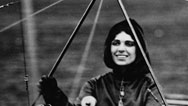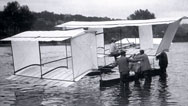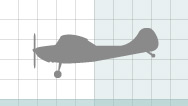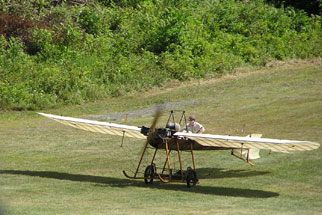Antique Aviation
- By David Levin
- Posted 11.07.06
- NOVA
At Old Rhinebeck Aerodrome, a "living" museum of aviation history, pilots coax antique machines made of wood, cloth, and wire into the skies over upstate New York. Some are unlike almost any modern aircraft. What's it like to fly them? We talked to three of the museum's pilots to find out.
This feature originally appeared on the site for the NOVA program Wings of Madness.
Transcript
Antique Aviation
Posted November 7, 2006
DAVID LEVIN: For aviation pioneers like the Wright Brothers and Alberto Santos-Dumont, there was only one way to learn to fly—take a deep breath, climb aboard, and go. At Old Rhinebeck Aerodrome and museum, not much has changed. Every weekend from June to October, Rhinebeck's staff coax antique machines made of wood, cloth, and wire into the skies over upstate New York. Some are unlike almost any modern aircraft—so what's it like to fly them? We talked to three of the museum's pilots to find out.
NEIL HERMAN: My name is Neil Herman. I've volunteered here for the last three years.
Each one of the planes has its idiosyncrasies. They all have their own personalities, their own starting techniques. And you get to know them like people. Like this plane is not going to start today because of the weather conditions. Or this plane is very tail-heavy, and it's going to take two or three people to pick up. The first step in getting familiar with the plane is learning the systems and taxiing the aircraft. And some of these, they require you taxi them many, many hours before you can even get in the air. And the first time, especially in a single-seat, fighter-type aircraft, it's a little quirky. You take it up to altitude, and you get used to it. And the first landing can be a little bit scary. We've had a few accidents here—minor accidents from checkouts of new aircraft and malfunctioning, cantankerous engines. You have to have a little bit of spine to do it. It's really not for the weak hearted. But the pleasure you get from flying something that very, very few people can fly is really amazing.
JIM RECORD: My name is Jim Record. I got started here, I think it was six seasons ago.
It's daunting. You know, it plays with your head a little bit, because you don't want to hurt the airplane, you don't want to damage it. But you're confident in the fact that you can fly other airplanes that are similar to this.
It's the taking off and landing and finding the runway just exactly the right place and landing it that's the challenge. You can do a couple practice approaches, come close to the ground but not actually plan on landing, just to see how it feels and what it looks like. And then when you're ready and you're confident, you actually come in and shoot your first approach and attempt your first landing. A lot of these airplanes don't have air speed indicators. You're feeling speed from the sound of the wind and the attitude of the airplane. You don't have time to think about how you feel, or you don't have time to think about being scared. All you're doing, every part of you, is working on doing the best job you can at flying the airplane.
CHAD WILLE: My name is Chad Wille. I have been a mechanic here, and I've also flown the airplanes here.
You have to take a step-by-step approach. You have to move backwards in time slowly and develop the skills that are necessary, some of which are opposite to what you're used to using to operate more modern aircraft. For earlier aircraft that have different types of control systems, you can get in them and, you know, do a flight of two or three feet up and down the runway for a very short distance. And you can feel what's happening. I mean, they're not totally foreign, they're still airplanes. But it does help to have thousands and thousands of hours of flying a variety of airplanes behind you.
What's going through my head is, "I don't want to break it." That's the number one concern. I build airplanes, and so I know how hard it is to build them and to rebuild them. And so, everything I'm concentrating on is to operate them safely enough to put them back down in one piece. I'm not frightened for myself, physically, because I always figure that if I can keep the airplane in one piece, then I'll be all right, just as a matter of course. With flying, we never stop practicing. Every flight, we're practicing. And it's a challenge, and it's fun.
Credits
Image
- (1910 Hanriot)
- Courtesy Sara Ascalon
Related Links
-

America's First Lady of the Air
Harriet Quimby was the first woman to fly the English Channel solo—and that's only part of her remarkable story.
-

Fantastic Flying Machines
Have a look at the wildly different aircraft that pioneering aviator Louis Blériot dreamed up in the early 20t...
-

Lift and Drag
What are lift and drag? And how do they work?
You need the Flash Player plug-in to view this content.


